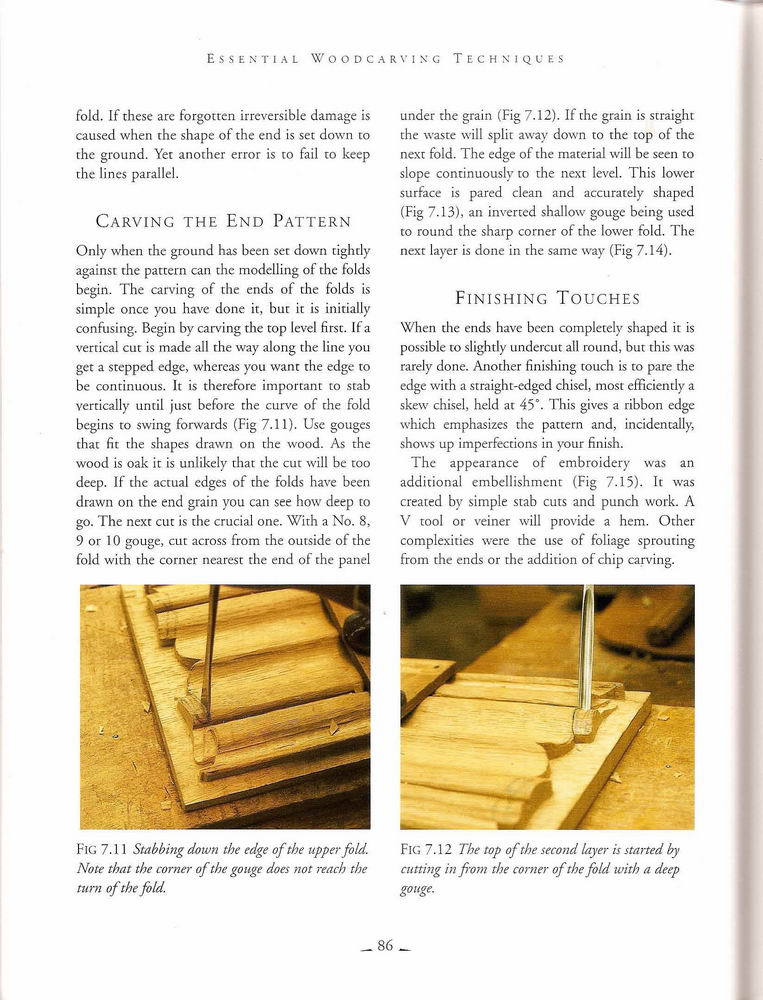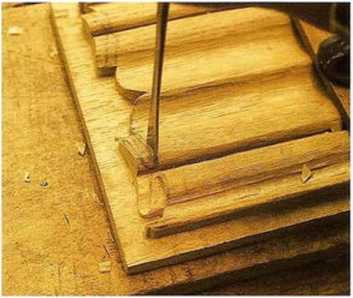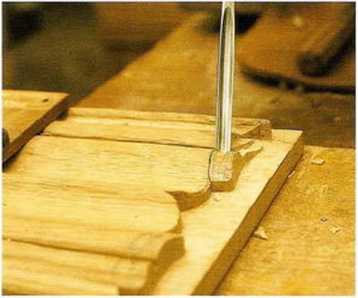essentÊrving°86

Essen tial W o o d c a r vin g Tech kiqu es
fold. If these arc forgotten irrcversible damage is caused when the shape of the end is set down to the ground. Yet another error is to fail to keep the lines parallel.
Carvinc the End Pattern
Only when the ground has been set down tightly against the pattern can the modclling of the folds begin. The carving of the ends of the folds is simple once you have done it, but it is initially confusing. Begin by carving the top level first. U a vertical cut is madę all the way along the linę you get a stepped edge, whercas you want the edge to be continuous. It is thereforc important to stab yertically until just before the curve of the fold begins to swing forwards (Fig 7.11). Usc gouges ihat fit the shapes drawn on the wood. As the wood is oak it is unlikely that the cut will be too deep. If the actual edges of the folds have been drawn on the end grain you can see how deep to go. The next cut is the crucial one. With a No. 8, 9 or 10 gouge, cut across from the outside of the fold with the corncr nearest the end of the panel under the grain (Fig 7.12). If the grain is straight the wastc will split away down to the top of the nexr fold. The edge of the materiał will be scen to slope continuously to the nexr level. This lower surfacc is pared clean and accurately shaped (Fig 7.13), an invertcd shallow gouge bcing uscd to round the sharp corner of the lower fold. The next layer is done in the same way (Fig 7.14).
Finishinc, Touches
When the ends havc been complctely shaped it is possible to slightly undercut all round, but this was rarely done. Another finishing touch is to parę the edge with a straight-edged chisel, most cfFicicntly a skew chisel, held at 45°. This gives a ribbon edge which emphasizes the pattern and, incidentally, shows up imperfections in your finish.
The appearance of embroidery was an additional embcllishmcnt (Fig 7.15). It was created by simple stab curs and punch work. A V tool or veiner will provide a hem. Other complexities were the use of foliage sprouting from the ends or the addition of chip carving.


Fic; 7.11 Stabbing down the edge of the upper fold. NotÄ™ that the corner of the gouge does not reach the tum of the fold.
Fic; 7.12 The top of the second layer is started by ctitting in from the corner of the fold with a deep gouge.
Wyszukiwarka
Podobne podstrony:
essent?rving?50 Essen tial W o o d c a r vin g Techniques Fig 3.11 Making the stab aa at too shallow
essent?rving?72 Essen tial W o o d c a r vin g Techniques Alder {Alnus glutinosa) Pale yellow or pin
essent?rving?16 Essen.tial Woodcarvmng Techsiques A clamp should be strong and have its heads in lin
essent?rving?34 Essen tial Woodcarying Techniques softwoods are evergreen and hardwoods are dcciduou
essent?rving?40 Essen tial Woodcarying Techniques FlG 2.20 Arrow Crosstree (Dick Onians), carued in
essent?rving?48 Essen tiał Woodcarving Techxiques Fig 3.5 From the bot tom: two correct chip cuts; t
essent?rving?52 Essen’ tial W o o d c a r v i n g Techniques Fig 3.18 A No. 3 fishtail being used to
essent?rving?58 Essen-tial Woodcarvig Techxiques Fig 4.10 Cu tti fig the cup. The gouge en ten the w
essent?rving?72 Essen tial Woodcarving Techniques although the temptarion ro use a router co set clo
essent?rving?20 Essen tial Woodcarving T e c h n i q u e sChoosing the BestDlRECTION OF THE GRAIN Th
essent?rving?62 Essen tial Woodcary ing T e c h n i q u e s Top arm comes just Hal
essent?rving?68 Essen tial Woodcarving Techniques FlG 15.16 The fint cut into the serif on an M. Fig
essent?rving?08 Essen t i a l W o odcarvin c, T e c h n i q u e s Fic 1.5 Backbcnt. FlC 1.4 Left- an
essent?rving?18 Essen tul Woodcarning Techniques Fig 1.29 A bench holdfast in use. Fig 1.28 A univer
essent?rving?20 Essen tul W o o d c a r v i n g Techxiquesmm FlG 1.33 Various rasps: from lefi, two
essent?rving?30 Essen ti al Woodcarving Techniques Fig 2.4 A piece of Southern yeUow pine. The dark
essent?rving?66 Essen ti al Woodcarvixg Techniques Fig 5.1 Oak leafstudies by a student (Howard Spie
essent?rving?68 E S 5E NTI A L W O O D C A R VIN G TECHNIQLES Fig 5.6 The gouge can removeplenty of
essent?rving?96 Essen ti al W o o dcaryinc T e c h niq u e s Fig S.18 Cutting across tbe gmin wbere
więcej podobnych podstron